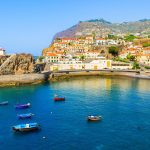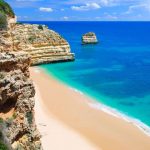Alone time in Portugal’s Alentejo region
What might travel be like during the recovery period once Covid-19 is under control? Thanks to its aggressive national response to the pandemic, Portugal is providing clues. Native Floridian Sheree M. Mitchell, founder and president of Lisbon-based boutique tour operator Immersa Global, recently completed a two-week trip through Portugal. In this, the third part of a four-part series of Dispatches, she shares what she’s discovered with Essential Business and Travel Weekly readers.
Article kindly submitted by Arnie Weissman, Editor-in-Chief, Travel Weekly
Having become accustomed to the new protocols in hotels and restaurants in the Algarve, I felt ready for the next leg of the trip: the Alentejo, a huge, sparsely populated region that sits to the southeast of Lisbon and to the north of the Algarve.
My first stop was a remote seaside town called Zambujeira do Mar on the Costa Vicentina, 51 miles north of Sagres. This stretch of coast is known for its unspoiled beaches and scenic hiking trails, both well-suited for social distancing. The drive, on mainly two-lane regional roads, was easy and fast — I was there in 90 minutes.
After checking into the boutique country inn where I was staying for the evening, I took a quick tour of the property and had lunch. They had implemented the same nationwide Clean & Safe sanitation measures as my previous hotel, so by now everything felt, well, normal.
After a late lunch I checked out the local scene, first by car to get a lay of the land and then by foot. I saw only eight other people; it felt like I had the entire seaside nature reserve to myself.
The next day I drove for two hours to the Alentejo’s main city, Évora. There I met Melanie Wolfram, the owner of the locally based Vagar Walking Tours, who had customized a program for me. This was actually my second private tour since March, so I was already familiar with the new Covid-19 “survival kit” that official tour guides distribute: extra personal protective equipment, hand sanitizer and, in case a client feels ill and needs to self-isolate, water and snacks. After we reviewed the new procedures, I was eager to chat with her — small business owner to small business owner — about how things were really going.
She confirmed exactly what I’d suspected: walking tours, like multiday small group programs, had all but died in March.
Even though it was odd to see Évora’s major historical sites empty, I must admit that there was something very special about having the Roman Temple all to ourselves. I’d been on private tours with Melanie before, but this time was different. She had time (and space) to point out details that had previously gone unnoticed. After, we headed to bustling Giraldo Square, where we joined locals for a quick midmorning coffee and pastry before walking to St. Francis Church. Our last stop, hidden in the interior of the church, was the eccentric Bone Chapel, famous for its macabre floor-to-ceiling wall decor that was sourced from nearby graves.
The tour over, I wished Melanie well and continued on to Estremoz, a small medieval town just 27 miles to the northeast. I had arranged to meet a local chef who had just opened Howard’s Folly, a restaurant/wine bar, in June. I was curious to know how that was working out, and I was also interested, from an operational point of view, in hearing about the adjustments they’ve had to make.
Chef Hugo Bernardo shared that, aside from having to get used to wearing a mask all day, modifications in the kitchen had been minimal. The same went for the changes needed to reconfigure the dining and lounge areas to allow for social distancing. However, the real challenge was the reduced capacity requirement and being unable to open the wine bar — a key element in his plans, since Howard’s Folly actually began as a winery years ago.
My last stop for the day was a tiny medieval village called Evoramonte, 11 miles southwest of Estremoz. I had chosen it for two reasons: one, it’s remote and two, it features the Place at Evoramonte, a four-bedroom, family-owned bed and breakfast owned and managed by a friendly and attentive Scottish couple.
And indeed, it was the place. During breakfast the following morning, co-owner Vicki Webber and I had a chance to chat. She said that they didn’t have any problems at all preparing the rooms and small cafe to meet the new health and sanitation requirements. (Luckily, they have plenty of outdoor dining space and private balconies, which really helped.) What was slightly challenging was converting the self-service buffet breakfast into the new pandemic-friendly a la carte without hiring extra support.
After breakfast, I headed to one of my favorite villages in the Alentejo: Vila Viçosa, 23 miles east of Evoramonte. This was my last stop in the region, and I was excited to have the chance to revisit a property that I knew well: the Alentejo Marmoris Hotel.
When I arrived, four differences from my previous visits immediately stood out: 1.) they take your temperature before you can check in; 2.) there’s a large plexiglass shield in reception between the attendant and guests; 3.) some of the spa and gym services were unavailable; and 4.) their Michelin-recommended restaurant now has a reduced schedule.
Fortunately, once I entered my room, I found very little had changed. Finally, after quite a bit of travel in areas I thought I knew, everything felt familiar again.
Next week: Northern Portugal
Grateful thanks also to Sheree Mitchell – Immersa Global, Visit Portugal which covered all expenses, Travel Weekly, Paulo Salvador and Mesa Nacional.










